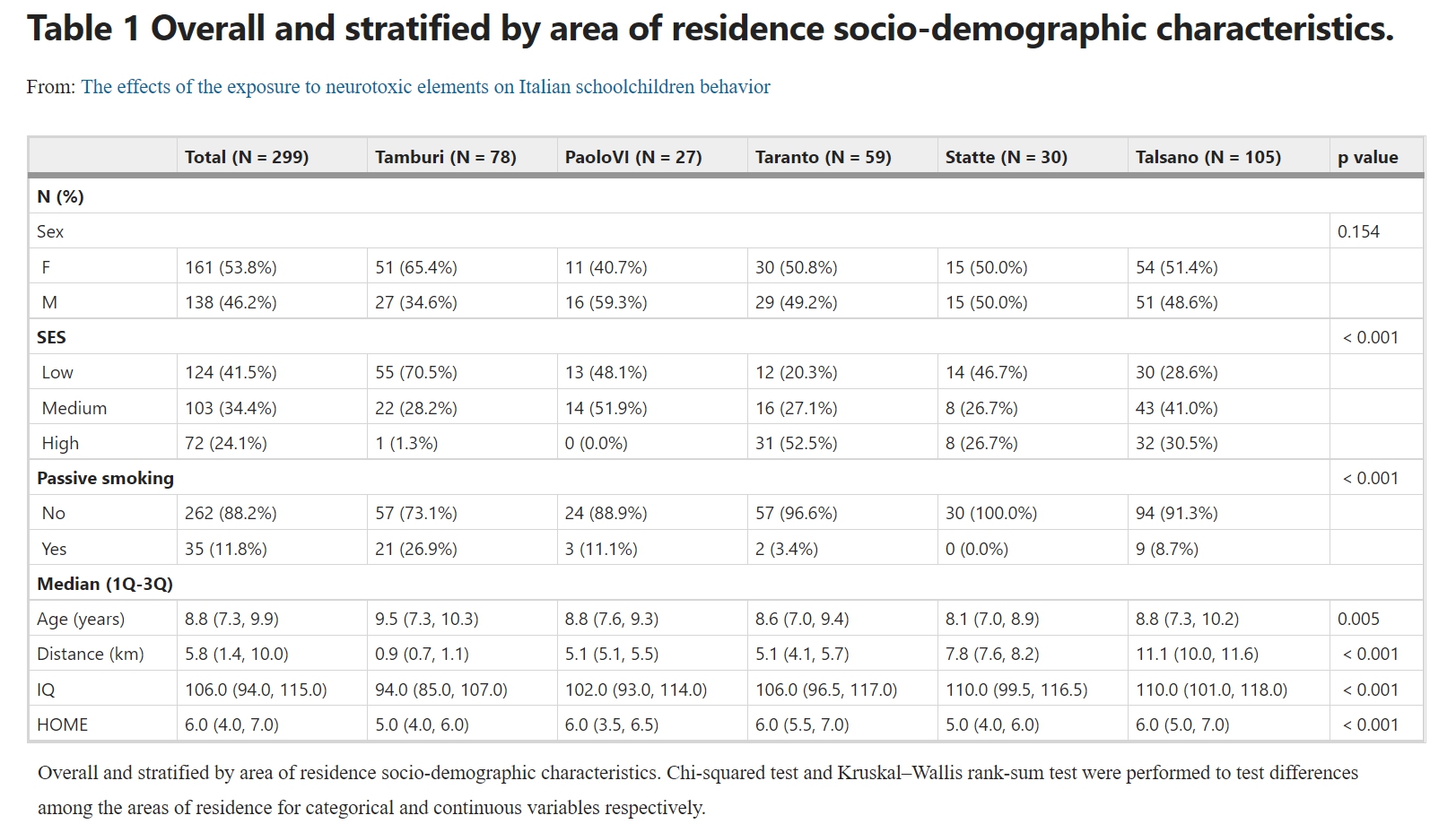The effects of the exposure to neurotoxic elements on Italian schoolchildren behavior
Stefano Renzetti, Giuseppa
Cagna, Stefano
Calza, Michele
Conversano, Chiara
Fedrighi, Giovanni
Forte, Augusto
Giorgino, Stefano
Guazzetti, Costanza
Majorani, Manuela
Oppini, Marco
Peli, Francesco
Petrucci, Anna
Pino, Donatella
Placidi, Oreste
Senofonte, Silvia
Zoni, Alessandro
Alimonti & Roberto
G. Lucchini
In this cross-sectional study we assessed the neurobehavioral effect of the exposure to trace elements including lead, mercury, cadmium, manganese, arsenic and selenium and their interactions among 299 schoolchildren residing in the heavily polluted Taranto area in Italy.
Results
Table 1 shows the overall socio-demographic characteristics of participants, grouped also by the area of residence. Two of the neighborhoods closer to the industrial site (Tamburi and Paolo VI) were characterized by a lower percentage of high-level socio-economic status (SES) (1.3% and 0% respectively, Chi-squared p-value < 0.001), a higher frequency of passive smoking exposure (26.9% and 11.1% respectively, Chi-squared p-value < 0.001) and lower Intelligence Quotient (IQ) (median IQ equal to 94 and 102 respectively, compared to 110 in the neighborhoods of Statte and Talsano, Kruskall–Wallis p-value < 0.001) Children residing in Tamburi also showed lower cognitive stimulation at home (median (1Q-3Q) HOME total score equal to 5.0 (4.0, 6.0), Kruskall-Wallis p-value < 0.001), were slightly older and had a higher percentage of females than children living farther from the source.
Metal concentrations showed a low inter-correlation (Table S1 of the Supplementary Material) with the highest value equal to 0.276 corresponding to the correlation between urinary As (UAs) and hair Hg (HHg).
After checking the assumption of a linear relationship through cubic splines (data not shown), we observed a negative trend of metal concentrations at increasing distance from the source of exposure (Table 2). Only HHg and blood Se (BSe) showed a positive association.
A poor agreement was found between parents and teachers evaluation (ICC ranging from 0.06 for anxiety problems to 0.36 for conduct problems) while the skewness and kurtosis highlighted a non-normal distribution of the lower level empirically-based syndrome and the DSM oriented scales (skewness and kurtosis above 0.5 and 3 respectively for all these outcomes). Tables 3 and 4 show median and 1st–3rd quartiles interval of the neurobehavioral scores including the CBCL empirically based and DSM oriented scales reported by parents and teachers respectively. Higher scores indicate higher levels of problems in an area meaning better performance in the more distant areas while lower scores indicate fewer problems. The p-value of the Kruskal–Wallis is also reported.
We found significant differences among the areas of residence for social problems, externalizing problems, oppositional defiant problems and the SRS total score reported by parents while for the teachers report there was a significant difference in all the scores apart from the thought problems, attention problems, affective problems, ADHD problems and oppositional defiant problems. Overall, we are able to see higher score values for the areas at closer distance from the emission source compared to those at greater distance.
Multicollinearity analysis was performed when multivariable models were applied: low VIF were observed for all the models fitted for each outcome (all VIF < 5). The marginal effects of the neurotoxic elements and 95% CI of the censored regression for the CBCL sub-scales are shown in Table 5 (only significant results were displayed). Significant positive association were found between blood Pb (BPb) and social problems and aggressive behavior scales while UAs has a greater impact on the anxious depressed, somatic complaints, attention problems and rule breaking behavior scales. The estimated effects of each models were at the net of sex, age, SES, distance from the source, IQ, exposure to passive smoking and HOME total score. In Table 5 are also reported the results of linear mixed effect models. In this case only BPb has a statistically significant impact on the externalizing and total problems scales of the CBCL, while UAs has a marginally significant association with total problems and the SRS total score. In this case the models were adjusted for the same covariates as the previous ones, but the random effects allowed to consider the nested structure of the data (subjects, schools and areas of residence). Overall, we were able to test that higher BPb or UAs concentrations are associated with increased neurobehavioral problems. All the other elements did not appear to have a statistically significant association with children neurobehavior. Semipartial correlations applied to multivariable models confirmed the results obtained and displayed in Table 5 and 6 showing higher R2 for BPb when considering the social problems, aggressive behavior, externalizing and total problems as dependent variables while UAs significantly increased the explained amount of variability of anxious depressed, somatic complaints, attention problems and rule breaking behavior (the proportion of explained variance associated to BPb and UAs was greater than 7% in all these cases).
READ MORE ON THE ORIGINAL SOURCE OF THE REPORT
We represented the effect of the interaction between BPb and UAs on CBCL total problems score in Fig. 2, to provide a better representation of how the association between the outcome and the BPb and UAs changed at increasing levels of the respective interacting element. A clear pattern of an increased metal impact on behavioral total problems at higher levels of both the element of interest and the interacting metal can be appreciated. The results for externalizing problems and SRS total T score are shown in Figs. S1 and S2 respectively of Supplementary Material.

READ MORE ON THE ORIGINAL SOURCE OF THE REPORT








